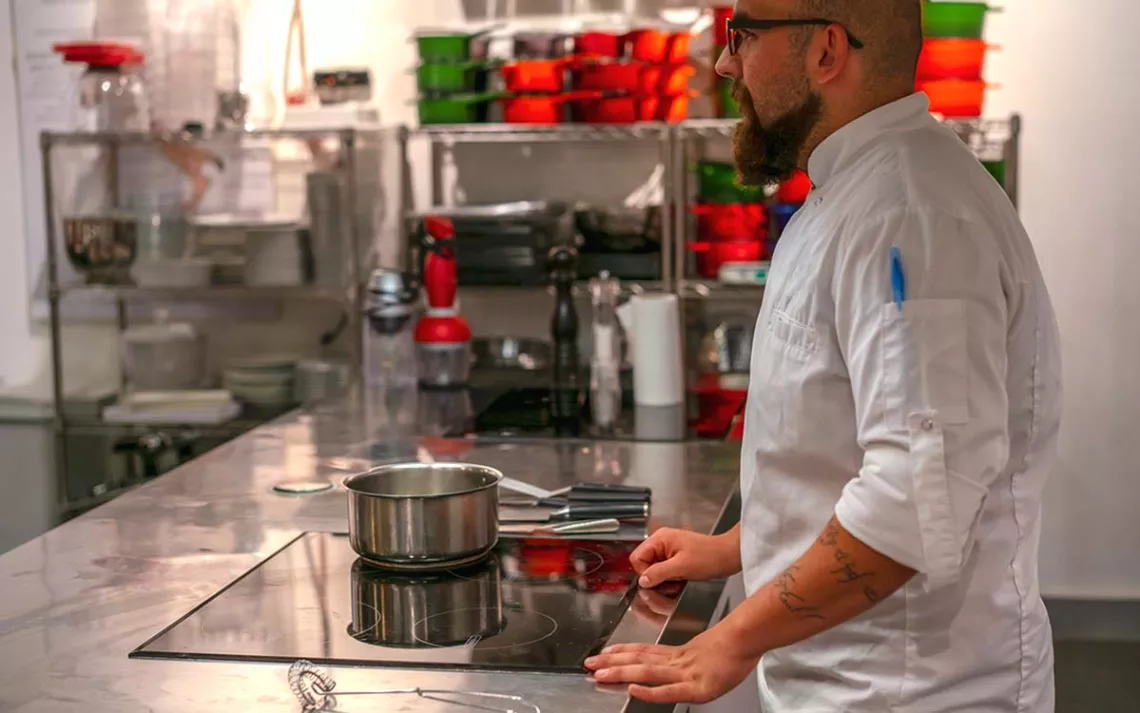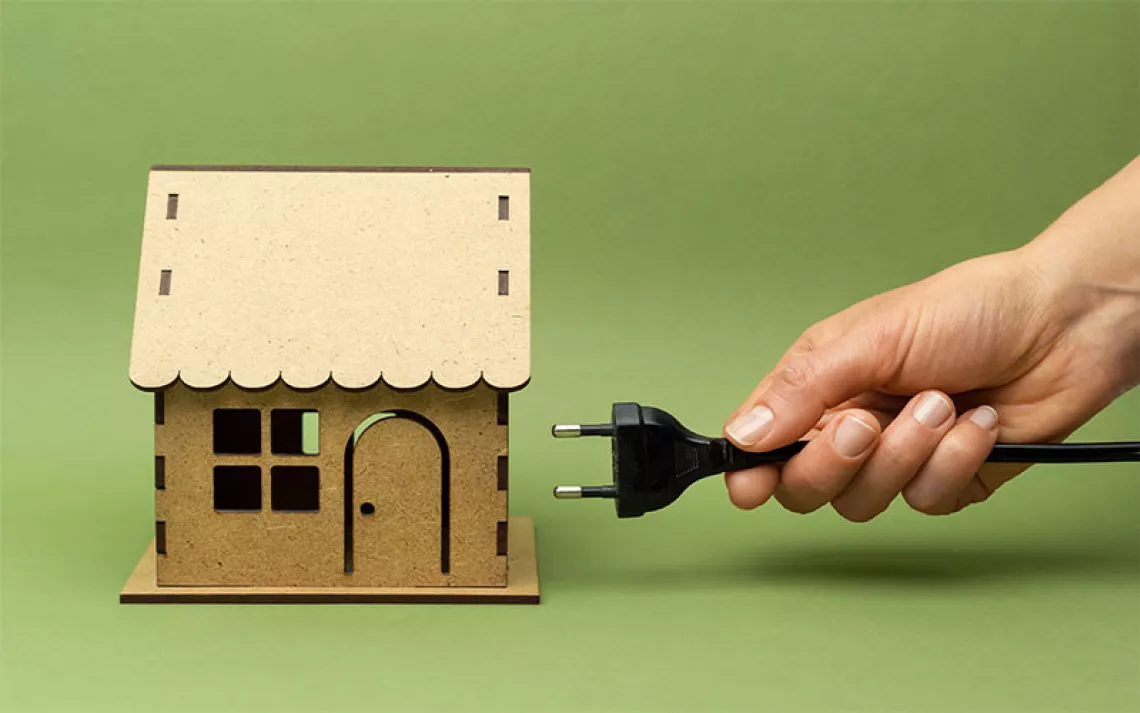Chefs Turn Off the Gas and Light Up Induction Cooktops
Electric induction stoves offer clean, efficient, and incredibly fast cooking without the methane gas

Photo by iStock/byakkaya
The cuisine was incredible, the views spectacular, the customers happy. But behind the scenes at one of Pittsburgh's top restaurants, the kitchen was like those in most other restaurants: a toxic sweatshop. Gas stoves, ovens, and broilers cooked not just the food but also the room and everyone in it, while spewing harmful pollutants that would be illegal outdoors.
One day in 2013, chef Christopher Galarza noticed that his coworkers all looked like him, drenched in sweat and heaving from the heat. Pausing at his station next to a sizzling flattop stove, with a hot oven behind him, he stuck an instant-read thermometer in his pocket: 135°F.
Almost nine years later, Galarza vows that he'll never cook with fire again. He speaks with the evangelical fervor of the convert about the energy and speed—as well as the health and environmental benefits—of induction stoves powered by magnetism, not methane. Galarza now advises companies like Microsoft on how to put out their pilot lights, part of a nationwide push to electrify the buildings that together generate 13 percent of US greenhouse gas emissions.
Studies have shown that in addition to cooking the planet, gas stoves are linked to respiratory diseases from the carbon monoxide, formaldehyde, and nitrogen dioxide they emit. One such study, published in Science, showed that people of color are disproportionately affected. Children raised with gas stoves are 42 percent more likely to suffer from asthma than kids in electric-stove homes, and NO2 levels in gas homes can run up to 400 percent higher, often exceeding EPA outdoor air-quality standards. (The EPA doesn't regulate indoor pollution.) Exhaust vents can help reduce—though not eliminate—the health risks by blowing the stuff outside, but most people rarely use them. A report released by Stanford University researchers in January found that three-quarters of a stove's methane emissions can occur when the appliance is turned off.
In the absence of federal regulation, communities across the country—beginning with Berkeley, California, and now including at least 50 other cities in the state as well as New York City and Seattle—have used their building codes and climate goals to ban gas connections in new buildings. Cities considering similar moves include Miami, Minneapolis, Denver, and Portland, Oregon, plus six in Massachusetts.
In a tactic copied from the backlash to the anti-plastic-bag movement, at least 15 states have passed laws prohibiting municipal gas bans. Oklahoma was the first, and now its principal gas utility is hoping to lock everyone into gas forever with a $1,400 "exit fee." And inevitably, gas proponents are trying to make the kitchen a new battlefield in the culture war. A recent headline in the National Review proclaimed "The Democrats' War on Gas Stoves Is a Slap at Cooking Cultures." The powerful California Restaurant Association sued Berkeley (unsuccessfully) for its gas ban, arguing that flame cooking is essential to chefs, especially for traditional and ethnic cuisines. Critics single out wok cooking, seemingly unaware that induction cooking is widely used throughout Asia.
Galarza says that cooks who've tried induction stoves love them, because they are precise, efficient, and incredibly quick, cooking up to twice as fast as gas stoves. According to Galarza, that's because gas stoves waste as much as 70 percent of their energy—that's why his old kitchen in Pittsburgh was so crazy hot—whereas induction stoves use 90 percent of their energy on cooking the food. Galarza says that he sometimes needs a sweater when he cooks.
Induction stoves are not only cheaper to operate but also less expensive when it comes to new construction, as they don't require gas lines. "For me, it was an economic no-brainer," says chef Michael Godlewski, who is opening an all-induction restaurant in Pittsburgh in spring 2022 called EYV (Eat Your Veggies). "They asked me where I wanted the gas line, and I said, 'Nowhere.'"
Magnetism, the magic behind induction stoves, is the same principle powering wireless phone chargers, power tools, and toy-train transformers. You know how such devices tend to get hot? Induction stoves make that the main point, harnessing it to cook. Because the electrical field is tightly focused, affecting only the very bottom of the pot (or wok), the rest—the handle, the top half of the pot, and of course the surrounding stovetop surface—stays cool. You can put your hand on the stovetop a half inch from what's cooking and not get burned.
This also makes cleanup easier (the spatter doesn't keep cooking as it does on the hot surfaces of gas stoves) and diminishes the likelihood of burns and fires, which could reduce insurance rates. The only limitation is that pots have to be made of steel or cast iron for the magneticism to work, which isn't much of a hardship for chefs, who prefer those materials anyway.
Top restaurants worldwide are adopting induction, including Michelin three-star restaurants Robuchon au Dôme in Macau, Alinea in Chicago, and the French Laundry in Napa Valley, California. Iron Chef Amanda Cohen pioneered all-induction cooking in 2008 in Dirt Candy, her renowned Manhattan vegetarian restaurant, and Top Chef Masters champion Rick Bayless and Canada's famed Angus An have sung the technology's praises.
It was Berkeley city councilwoman Kathleen Harrison, though, sponsor of the city's gas-ban ordinance, who illustrated the best way to win over skeptics. In the middle of a meeting, hoping to show up those who thought induction cooking was second-rate, she made chocolate fondue on a portable induction burner. The ordinance passed after she handed out samples.
"It was delicious," she recalls.
This article appeared in the Spring 2022 quarterly edition with the headline "Kitchen Remodel."
 The Magazine of The Sierra Club
The Magazine of The Sierra Club



